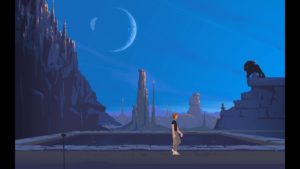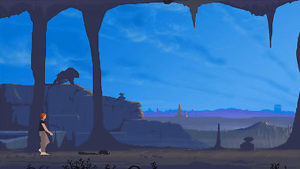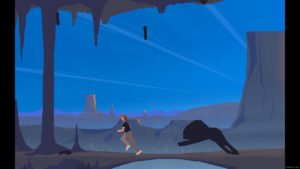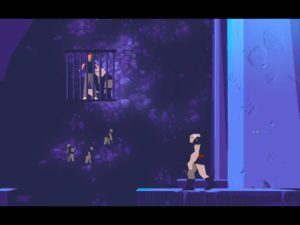Another World is a 2-D one-player action-adventure game designed by Eric Chahi and published by Delphine Software in 1991. The plot centers around Lester, a scientist that fights for survival in a dangerous alien world after one of his experiments goes wrong. The player’s objective is to go through several puzzle scenes, avoid obstacles, and escape creatures by running, shooting, and jumping. Another World uses design and mechanics to handle space and time and help the player better understand how to interact with the game world.
Level Design
Another World’s space is divided up in rooms that belong to different levels which players can navigate one at a time and can move to the next by reaching one of the edges of the screen. The design helpfully breaks up the levels into smaller pieces. This lets the player know that something has to be done in each room to solve the level and move to the next. For example, some of the rooms belonging to the first puzzle are arriving at the alien world, the jumping over leeches, and the running of the beast. Usually, the objects of the rooms stay in the rooms (except for the beast that ends up chasing the character), but they are connected to objects seen in past rooms.

Arriving to alien world

Avoiding leeches

Escaping beast
The fact that the design of the background image is static in each room helps to split the game up into different puzzle pieces. However, what is even better is that, unlike other platformer games that we discussed in class, the static background changes in every room. This helps give the player a sense of progress and continuity in the game. It is important to note that while the background is different, it is still related to the level.

Background 1

Background 2
Having smaller puzzles due to having the game’s space be split into rooms doesn’t always mean the game will be easier. When I was inside the cave, I encountered many screen edges that led to many similar-looking rooms. I didn’t know in which direction to move next and got lost in the maze. Having a design that simplifies large puzzles, aids players. And while it may get confusing and challenging at times, players still know there is a puzzle to solve in a specific room before they go on to the next one.
Time Mechanics
Another World’s does not use time in a traditional sense. There is no timer on the right side of the screen telling players how much longer they have to complete a room or a level. Instead of tracking players using a time counter, the game tracks players through checkpoints. If a player is able to reach a certain point without dying, no matter how much time it took him to get there, then the player can restart at that point indefinitely. This checkpoint mechanic is pretty useful and contributes greatly to the space design.
The checkpoint is so helpful mainly because Lester is a vulnerable character that cannot sustain any damage. The game ends immediately every time he gets shot by a gun, touched by an animal, or crushed by a rock. I remember dying more than fifteen times at the hands of deadly leeches. At first, I didn’t know why. But when I finally understood, I knew the only way to get rid of them was to kick them from a reasonable distance. I also got killed so many times by a guard that was able to see me before I did. After several times I knew I had to shoot the gun before crossing over the edge of the screen. And inside the cave, I didn’t know that stalagmites would end my life more until I learned I had to jump over them. Another World is the personification of trial and error. The game uses checkpoints to help players overcome a particular obstacle with as much time that is needed without having to redo the entire game.

Jumping to avoid death
I truly believe that if time were used in a traditional sense, the rooms and the level progression would not be as effective. The player would be more concerned with trying to finish the game in time and die even more often. The game is complex enough without the time mechanic and it allows players to learn from their mistakes.
Conclusion
Another World is a great cinematic platformer that truly helps the player understand the fictional world as a version of reality through the use of space and time. Through the use of space, it allows the players to explore, with constraints, an alien world. Each room shows a beautiful background, a dangerous creature, and a challenge to solve. The graphics found in the room design are also great contributors for the player to engage in the world, its narrative, and understand how to move around in it. In terms of time, the player is able to see a progress that is more similar to our version of reality. The game doesn’t have a counter telling you when you need to restart. Its use of checkpoints, trial and error, and restarting are better suited to the narrative of the game.